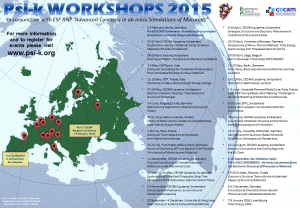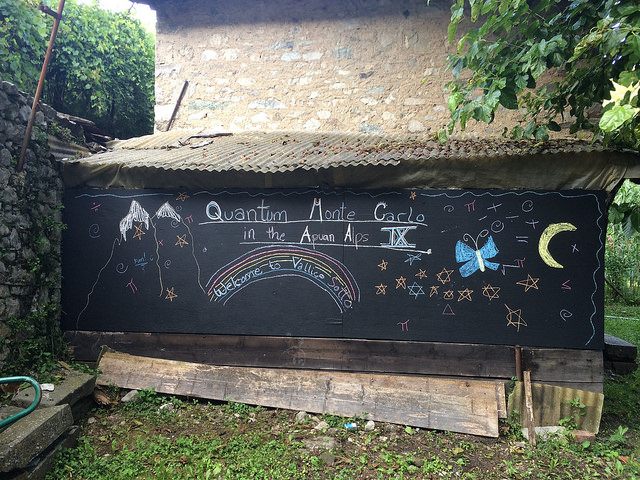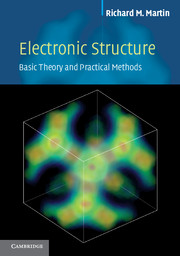The next Psi-k conference will take place in September in San Sebastian, Spain. Have you registered yet?
Further details and a registration form can be found here.
The next Psi-k conference will take place in September in San Sebastian, Spain. Have you registered yet?
Further details and a registration form can be found here.
Psi-k has a full programme of workshops, conferences and hands-on tutorials taking place throughout Europe in 2015.
For further details please see the poster below or visit the events section.

Please read this announcement about the new Psi-k mailing list.
MISSION: Psi-k is a Europe-based, worldwide network of researchers working on the advancement of first-principles computational materials science. Its mission is to develop fundamental theory, algorithms, and computer codes in order to understand, predict, and design materials properties and functions. Theoretical condensed matter physics, quantum chemistry, thermodynamics, and statistical mechanics form its scientific core. Applications encompass inorganic, organic and bio-materials, and cover a whole range of diverse scientific, engineering, and industrial endeavours. Key activities of Psi-k are the organization of conferences, workshops, tutorials and training schools as well as the dissemination of scientific thinking in society.
Psi-k is a bottom-up researchers’ network, established in 1994, to build strength and cooperation in the field of computational electronic structure. Psi-k activities are coordinated by a Board of Trustees, a Scientific Advisory Committee, and 16 Working Groups. These activities encompass the organization or co-sponsoring of ~30 workshops, conferences, schools or tutorials every year, an annual research conference jointly with CECAM, and a major conference covering the entire field every 5 years.
In addition, Psi-k produces a regular newsletter with extensive scientific highlights, and allows researchers to advertise job openings, events, and other topics of mutual interest through its 5000+ members mailing list.
This new website — introduced in 2015 to replace a venerable old site that provided sterling service over many years — offers a much more flexible modern design and functionality and it is to be hoped that it will provide even more stimulus for collaboration and cooperation amongst its members. Instructions regarding how to use it are here.
|
Psi-k is a registered charity and can only continue to operate thanks to the contributions from our member organisations and institutions. If you would like to make a donation to Psi-k please contact us to request an invoice or make a donation directly through our PayPal account… |
Sam and I were in Pisa recently at the invitation of Prof. Vincenzo Barone from the Theoretical Chemistry group at the Scuola Normale. Prof. Barone is amongst other things, Professor of Theoretical and Computational Chemistry in Pisa, President of the Italian Chemical Society, and author of more than 650 publications, which for a young man like me still stuck on around 60 papers is something to aspire to, to say the least.
Despite the literal meaning of ‘Normal School’ – which in English sounds like somewhere you go if you can’t get into a good school – the Scuola Normale is probably Italy’s most prestigious university – founded in 1810 by Napoleonic decree as the sister of the École Normale in Paris. It is very much an elite institution, and to become a student there, candidates have to pass an extremely selective admissions exam with only a 6% pass rate – every year only sixty candidates are admitted out of nearly 1000 applicants. The main building is the overwhelmingly beautiful Palazzo della Carovana (pictured above) which was designed and built by Giorgio Vasari in the 1500s as the headquarters of the Knights of Saint Stephen. It is situated in Piazza dei Cavalieri – the second main square in Pisa and right in the heart of the action. What a fantastic place to work, I have to say! It certainly beats the modern incarnation of the pebble-dashed prefab Cavendish Laboratory – which was moved out of the centre of Cambridge to a field three miles away in the 1970s. This was done at probably the worst moment in history for British architecture at a cost of only two million pounds and it really shows; despite inflation that wasn’t very much money back then either.

A great deal of interesting science was presented and discussed at the meeting, and much of this is summarized in the scientific report further down this page. I think it’s now clear to most people that the quantum Monte Carlo method is continuing to grow in utility and importance, and for those with a big enough computer it self-evidently ought to be the method of choice for highly accurate benchmark quantum-mechanical calculations of molecules and materials — certainly those with more than a few atoms.
Continue reading Conference report: Quantum Monte Carlo in the Apuan Alps IX
In the U.K. and other countries there is an increasing pressure for funding agencies to demonstrate the social and/or economic benefits of the research they sponsor. Two recent attached reports that were initiated by Mike Payne and produced by Goldbeck Consulting for the UK-JCMaxwell CECAM node address this issue. Continue reading Industrial Impact
Two silicon-vacancy centers in diamond can emit photons that are indistinguishable—suggesting they have potential as building blocks for a diamond-based quantum computer. [link]
“The effect of electron correlation on the electronic structure and spin lattice coupling of the high-Tc cuprates: quantum Monte Carlo calculations” by Lucas K. Wagner and Peter Abbamonte [link]
Really interesting that people are doing high Tc cuprates with QMC now.. things have come a long way since Ceperley and Alder..

The study of the electronic structure of materials is at a momentous stage, with the emergence of computational methods and theoretical approaches. Many properties of materials can now be determined directly from the fundamental equations for the electrons, providing insights into critical problems in physics, chemistry, and materials science. This book provides a unified exposition of the basic theory and methods of electronic structure, together with instructive examples of practical computational methods and real-world applications. Appropriate for both graduate students and practising scientists, this book describes the approach most widely used today, density functional theory, with emphasis upon understanding the ideas, practical methods and limitations. Many references are provided to original papers, pertinent reviews, and widely available books. Included in each chapter is a short list of the most relevant references and a set of exercises that reveal salient points and challenge the reader.
Highly recommended!
Listen to Barber’s Adagio for strings here.